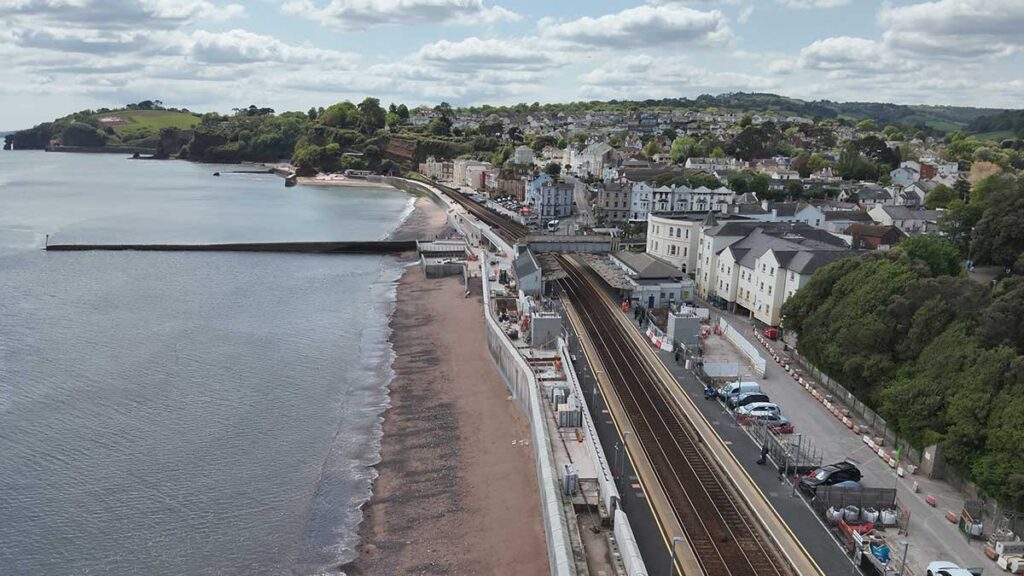Dawlish sea wall – section two
Section two of £80 million Dawlish sea wall completed.

The transformation of Dawlish seafront is complete after 415m of new promenade along, with other fully accessible public areas, opened to the public on 25 May 2023.
The second section of the new sea wall between Coastguards and Colonnade breakwaters will help protect the railway from extreme weather and rising sea levels for generations to come
It is linked to the first section at Marine Parade by a new footbridge, running parallel to the railway viaduct.
Completion of the £80m Government-funded project means the community and visitors to Dawlish can now enjoy the accessible high-level promenade all the way from Boat Cove to Coastguards footbridge, where it then joins the original sea wall. The beach in the same section has also reopened to the public now that construction is complete.
What did we do?
Construction began on the second section in November 2020 following completion of the first phase, which runs for 360m alongside Marine Parade and opened to the public in July that year.
An innovative eight-legged, self-contained walking jack-up barge, known as a ‘Wavewalker’, was used during the construction – the first time this type of barge was used to upgrade the UK rail network. It allowed the team to work across high tidal ranges that particularly impact the south Devon coastline.
The wall itself was substantially completed in July 2022, when all 164 front panels, 203 pre-cast blocks and 189 recurve units which return waves back out to sea were in place. This milestone gave the iconic stretch of railway line immediate greater resilience against waves that flood the track, leading to potential closures and delays.
Work was then carried out to complete the promenade, seating areas, ramped access to the beach and a new stilling basin, where Dawlish Water runs under the viaduct into the sea.
The new section of wall wraps around Dawlish station, where work is continuing to build an accessible footbridge with lifts for passengers, which is set to be completed later in 2023.
Although it offers 21st Century protection and full accessibility, the new sea wall features many nods to the town’s history; the footprint of the old Coastguards boathouse is shown on the new promenade, while the wall in front of the station features outlines of the alcoves that previously provided seating. Reclaimed stone from the old wall has been used to create new benches.
The design of the 8m high sea wall, which is 2.5m taller than the previous one, followed years of detailed studies, designs and joint working between world-leading marine, coastal and railway engineering experts. It was developed as part of the South West Rail Resilience Programme, put in place to improve resilience between Exeter and Newton Abbot, after the major storm of 2014.
The entire sea wall project has given the local economy a £15million boost through Network Rail and its contractor BAM Nuttall’s commitment to using local labour, materials and accommodation, wherever possible
What are the benefits?
The project will:
- Help to protect the railway from the sea, leading to fewer line closures and a quicker recovery after large storm events to enable a normal service to resume.
- Improve the experience for passengers getting on and off trains during high tides and stormy weather by reducing the overtopping and spray reaching the platform.
- Help preserve the coastal path for future generations, as well as create opportunities to enhance the promenade, including more seating.
- Protect the new, higher-level promenade from inundation by beach material, making the area more accessible for all.
- Remove pigeon roosts, leading to a cleaner promenade and improved water quality.
- Make travel easier for passengers with disabilities/pushchairs/heavy luggage by providing an accessible footbridge.
- Improve safety by removing the barrow crossing currently used for escorting passengers with disabilities.
- Potentially bring more of the station building into use and provide longevity and protection to the listed station building itself.
Project history
Environmental implications
Detailed environmental and habitat studies have been undertaken and these concluded that the works will have a limited impact on the marine environment around Dawlish.
Any potential to cause harm during construction will be closely monitored and managed through the Marine Licence process.
Marine Management Organisation – Environmental Impact Assessment Screening
The planning process
The local planning authority, Teignbridge District Council, granted prior approval and Listed Building Consent for our proposals in August 2020.
The plans for ‘prior approval’ were submitted under our permitted development rights, enabling the council to formally consult the local community on the proposed designs. Listed Building Consent was sought as the works are physically attached to the Grade II listed Dawlish Station.
The letters of submission and all the supporting documents and drawings are available to download below.
In addition to the planning and heritage consents, an application for a Marine Licence has been submitted to the Marine Management Organisation.
Contact us
If you have any questions about the plans, you can send us an email at: SouthWestRRP@networkrail.co.uk
You can also visit our contact us page, call our 24-hour national helpline on 03457 11 41 41 or you can contact us on Twitter at @SouthWestRRP